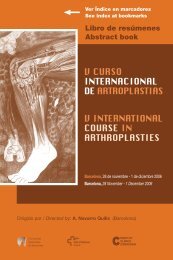Notas / Notes - Active Congress.......
Notas / Notes - Active Congress.......
Notas / Notes - Active Congress.......
You also want an ePaper? Increase the reach of your titles
YUMPU automatically turns print PDFs into web optimized ePapers that Google loves.
MIÉRCOLES / WEDNESDAY<br />
72<br />
3. Harris WH, Crothers O, Oh I: Total hip replacement and<br />
femoral head bone grafting for severe acetabular<br />
deficiency in adults. J.Bone Joint Surg 1977;59-A:752-<br />
5.<br />
4. Hartofilakidis G, Stamos K, Karachalios T, Ioannidis TT,<br />
Zacharakis N: Congenital hip disease in adults: Classification<br />
of acetabular deficiencias and operative<br />
treatment with acetabuloplasty combined with total hip<br />
arthroplasty. J.Bone Joint Surg 1996;78:683-692.<br />
5. Paavilainen T: Total hip replacement for developmental<br />
dysplasia of the hip. Acta Orthop Scand 1997;68:77-84.<br />
6. Cabanela ME: Total Hip Arthroplasty: Degenerative<br />
Dysplasia of the Hip. In: Advanced Reconstruction Hip.<br />
Ed: Lieberman J, Berry D. AAOS. 2005:115-20.<br />
7. Slooff TJJH, Huiskes R, van Horn J, Lemmens AJ.: Bone<br />
grafting in total hip replacement for acetabular protrusion.<br />
Acta Orthop Scand 1984;55:593-6.<br />
8. Yasgur D, Stuchin S, Adler E, DiCesare P.: Subtrochanteric<br />
Femoral Shortening Osteotomy in Total Hip<br />
Arthroplasty for High-riding Developmental Dislocation<br />
of the Hip. J. Arthroplasty 1997;12:880-7.<br />
9. Rorabeck C, Burnet SJ: Total Hip Arthroplasty: High Hip<br />
Dislocation. In: Advanced Reconstruction Hip. Ed: Lieberman<br />
J, Berry D. AAOS. 2005:121-9.<br />
10. lkka Helenius, Ville Remes, Kaj Tallroth, Jari Peltonen,<br />
Mikko Poussa, and Timo Paavilainen<br />
Total Hip Arthroplasty in Diastrophic Dysplasia<br />
J. Bone Joint Surg. Am., Mar 2003;85:441-447.<br />
32. Caveiro N: Experiencia personal con la ATC en DDH.<br />
Libro de resúmenes. SPOT Vilamoura 2007<br />
HIP RESURFACING ARTHROPLASTY IN<br />
DYSPLASTIC HIPS<br />
Michael Menge<br />
St. Marienkrankenhaus,<br />
Ludwigshafen (Germany)<br />
BACKGROUND<br />
The long term prognosis of total hip replacement (THR) is<br />
poor in younger patients. Therefore bone sparing techniques<br />
as resurfacing of the femoral head have become very popular<br />
in Germany. As patients with congenital dysplasia of the hip<br />
(CDH) very often develop early osteoarthrosis there might<br />
be the possibility to use this procedure in anatomically difficult<br />
cases. The purpose of this study was to evaluate the possibilities<br />
and the problems in resurfacing dysplastic hips.<br />
METHOD<br />
Between 1999 and 2006 more than 1.500 patients received<br />
a MoM resurfacing of the hip, from which 91 patients (6%)<br />
suffered from severe secondary osteoarthrosis after mild or<br />
severe CDH. The rate of dysplastic hips in our total hip replacement<br />
(THR) group was less because the high number<br />
of degenerative coxarthrosis of the elderly: 177 out of 6875<br />
cases (2.6%). The mean age from our CDH patients was<br />
47.7 years (30.7 – 64.9). In most cases the posterior approach<br />
was used, only two surgeons of our staff preferred the lateral<br />
approach.<br />
RESULTS<br />
In most cases the resurfacing of the head was not the<br />
problem but the fixation of the acetabular socket in a shallow<br />
acetabulum with bone defects mostly at the anterior rim. Two<br />
devices worked fairly well in these circumstances: The BHR<br />
and the Icon dysplasia cup with additional fixation screws<br />
from the upper rim. We additionally tried the ESKA Bionik<br />
system offering a modular socket allowing screw fixation of<br />
the outer shell then covered by a metallic liner. In dysplatic<br />
acetabula the missing macro- and microstructure at the central<br />
back of the ESKA sockets let to a higher revision rate.<br />
Typical cases and problems will be demonstrated.<br />
CONCLUSIONS<br />
Our 9-year experiences with MoM resurfacing procedures in<br />
young patients with osteoarthrosis are excellent. In CDH the<br />
resurfacing procedure may be extremely difficult and there<br />
were more complications, especially loosening of the socket<br />
or femoral nerve palsies due to the missing ventral wall of<br />
the acetabulum. There was a revision rate of 10% in the cases<br />
with severe dysplastic acetabula. In the majority the patients<br />
will profit from good function and in the future in case<br />
of revision from preserved bone stock at the femoral side.<br />
CHARNLEY LOW-FRICTIONAL<br />
TORQUE ARTHROPLASTY. FOLLOW-UP<br />
TO 38 YEARS.<br />
PROBLEMS AND SOLUTIONS<br />
B. M. Wroblewski, P. D. Siney, P. A. Fleming<br />
The John Charnley Research Institute, Wrightington Hospital,<br />
Hall Lane, Appley Bridge Near Wigan (Great Britain)<br />
We studied survivorship after Charnley low-frictional torque<br />
arthroplasty with revision as the end point.<br />
Between November 1962 and June 2005, 22,066 primary<br />
operations had been carried out at Wrightington Hospital by<br />
over 330 surgeons. By June 2006, 1001 (4.5%) hips had been<br />
revised.<br />
Survivorship analysis at 38 years with revision as the end<br />
point was: Infection 95%, dislocation 98%, fractured stem<br />
88.6%, loose stem 72.5% and loose cup 53,7%.





